This Bible study lesson is based on Chapters 1 and 2 of The Abiding Room, a book by Kevin Seacat.
* * * * * * *
Unfortunately, too few Christians are experiencing the abundant, Spirit-filled life that Christ offers. It is estimated that only about 5 percent of believers are living in the power of the Holy Spirit. While the exact figure may be difficult to determine, it is clear that only a small minority of Christians are enjoying the fullness of life that God has planned for us. This is both unfortunate and unnecessary.
God intends for every follower of Jesus to experience the fruits of the Holy Spirit outlined in Galatians 5: love, joy, peace, patience, kindness, goodness, faithfulness, gentleness, and self-control. These are the incredible blessings of Spirit-filled living that we are about to explore. As you experience the presence of Jesus and the power of the Holy Spirit, you will also come to know God’s will for your life more clearly.
Throughout the Bible, God provides stories and instructions illustrating that, at any given moment, our relationship with Him exists at one of three levels. Only in Level III, the Abiding Room, do we experience God in the fullness He intends for us.
The Garden of Eden
The 3 Levels of Life first became evident in the Garden of Eden. Initially, mankind—Adam and Eve—was sinless, walking in a harmonious relationship with God. God provided everything they needed, and there was no death or separation because there was no sin. At this stage, there was only one level of life, as depicted in this diagram:
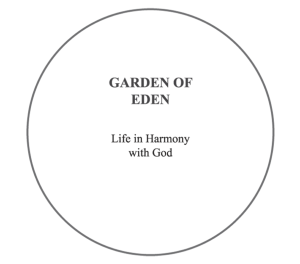
Life with God was as He intended, but He gave Adam a command and warning: “You may surely eat of every tree of the garden, but of the tree of the knowledge of good and evil you shall not eat, for in the day that you eat of it you shall surely die” (Genesis 2:16–17 NIV). Satan deceived Adam and Eve, leading them to disobey God by eating from the forbidden tree.
This broke the perfect, harmonious relationship between a holy God and now-sinful mankind. Because God is holy, He imposed consequences for sin. One consequence was banishment from the Garden: “So, the Lord God banished him from the Garden of Eden to work the ground from which he had been taken. After he drove the man out, he placed on the east side of the Garden of Eden Cherubim and a flaming sword slashing back and forth to guard the way to the tree of life” (Genesis 3:23–24 NIV). This introduced two levels of life, as shown in the next diagram:
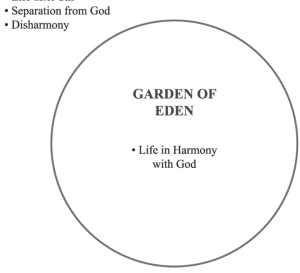
Ultimately, their sin led to another consequence: death for all. “The man has now become like one of us, knowing good and evil. He must not be allowed to reach out his hand and take also from the tree of life and eat, and live forever” (Genesis 3:22 NIV). “Altogether, Adam lived a total of 930 years, and then he died” (Genesis 5:5 NIV). Thus, the 3 Levels of Life emerged, as illustrated below:
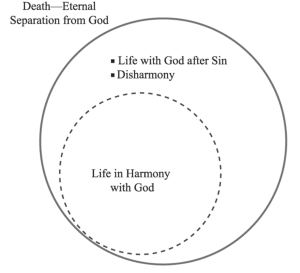
The Bible teaches that sin continues to impact all humankind: “Therefore, just as sin came into the world through one man, and death through sin, and so death spread to all men because all sinned” (Romans 5:12 NIV). The entire Bible demonstrates that our relationship with God exists at one of these three levels. Only one level—living in harmony with God—is truly pleasing to Him, yet few consistently live this way.
Romans 7 and 8
Becoming a Christian involves repentance and belief: “Jesus came into Galilee, proclaiming the gospel of God and saying, ‘The time is fulfilled, and the kingdom of God is at hand; repent and believe in the gospel’” (Mark 1:14–15 NIV). From an unbeliever, one accepts Jesus’ invitation to become a believer.
Salvation is a one-way journey, secure and irrevocable. Jesus assures eternal security: “I give them eternal life, and they shall never perish; no one will snatch them out of my hand. My Father, who has given them to me, is greater than all; no one can snatch them out of my Father’s hand” (John 10:28–29 NIV).
The Bible confirms this certainty through the Holy Spirit, received at conversion to indwell forever: “When you believed, you were marked in him with a seal, the promised Holy Spirit, who is a deposit guaranteeing our inheritance until the redemption of those who are God’s possession—to the praise of his glory” (Ephesians 1:13–14 NIV). This assurance is depicted in the following diagram:
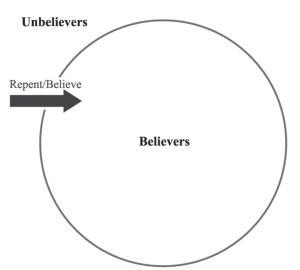
Living in the Flesh
With confidence in salvation, believers choose moment-by-moment to live in either the flesh or the Spirit. In Romans 7, Paul describes the struggle of living in the flesh: “For I do not understand my own actions. For I do not do what I want, but I do the very thing I hate” (Romans 7:15 NIV).
“For I know that nothing good dwells in me, that is, in my flesh. For I have the desire to do what is right, but not the ability to carry it out. For I do not do the good I want, but the evil I do not want is what I keep on doing” (Romans 7:18–19 NIV). He cries out in desperation: “Wretched man that I am! Who will deliver me from this body of death?” (Romans 7:24 NIV).
Living in the Spirit
In Romans 8, Paul describes the freedom and victory of living by the Holy Spirit’s power, enabling a life free of sin and filled with peace: “There is therefore now no condemnation for those who are in Christ Jesus. For the law of the Spirit of life has set you free in Christ Jesus from the law of sin and death” (Romans 8:1–2 NIV).
“For those who live according to the flesh set their minds on the things of flesh, but those who live according to the Spirit set their minds on the things of the Spirit. For to set the mind on the flesh is death, but to set the mind on the Spirit is life and peace” (Romans 8:5–6 NIV). This illustrates the 3 Levels of Life, as shown in the diagram:
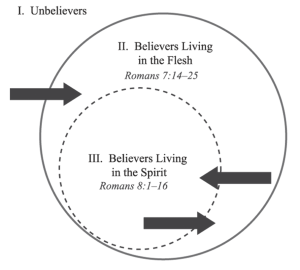
1 Corinthians 2 and 3
Can you know what God desires you to do? Yes! In the Abiding Room, God’s instructions become clear. In 1 Corinthians, Paul describes three types of people, illustrating the 3 Levels of Life.
Level I—The Natural Person
“The natural person does not accept the things of the Spirit of God, for they are folly to him, and he is not able to understand them because they are spiritually discerned” (1 Corinthians 2:14 NIV).
Level II—The Fleshly Person
“But I, brothers, could not address you as spiritual people, but as people of the flesh, as infants in Christ. I fed you with milk, not solid food, for you were not ready for it. And even now you are not yet ready, for you are still of the flesh. For while there is jealousy and strife among you, are you not of the flesh and behaving only in a human way?” (1 Corinthians 3:1–4 NIV).
Level III—The Spiritual Person
“The spiritual person judges all things, but is himself to be judged by no one. ‘For who has understood the mind of the Lord so as to instruct him?’ But we have the mind of Christ” (1 Corinthians 2:15–16 NIV).
Paul’s words to the Corinthian church clarify three spiritual states, relevant today. In 1 Corinthians 2, he contrasts the natural person (Level I), who cannot understand God’s things without the Holy Spirit, with the spiritual person (Level III), who discerns God’s truths through the Spirit.
In chapter 3, he places the Corinthians at Level II—saved but fleshly, acting like infants, unable to grasp deeper truths due to jealousy and strife. Their actions cause church conflict, requiring Paul to address their behavior rather than deeper spiritual truths. He implies this is a choice, not a permanent state: not ready and still of the flesh.
Believers can move to Level III, living spiritually, in harmony with God, led by the Holy Spirit, with a clearer understanding of their purpose, as shown in the diagram
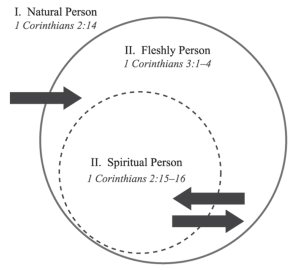
The Corinthians’ failure to utilize the Holy Spirit’s power reflects a choice. Believers today face the same choice: live in the flesh (Level II) or the Spirit (Level III), the Abiding Room, where harmony with God and others is possible.
A Word about the Limitations of Diagrams
These diagrams illustrate the three levels of life, showing the contrast between living by the Holy Spirit versus the flesh. The outer circle’s solid line represents a spiritual boundary crossed only by God’s act, while the inner circle’s dashed line signifies a boundary believers can cross through choice.
However, these diagrams present spiritual conditions as absolutes—fully in Level I, II, or III—while reality is less clear, often shaded in gray. The Bible uses absolute terms like filled with the Spirit, never partially filled.
Yet, these illustrations, though biblically based, cannot fully capture the complexities of our spiritual walk in a fallen world. They are tools to guide us toward a fuller relationship with God, acknowledging their limitations in explaining spiritual truths. Now, let’s explore the Holy Spirit’s truths.
ABIDING TRUTH: The New Testament confirms and illustrates The 3 Levels of Life.
Reflection Question
What are some of the ways you have found to regularly impact your development toward spiritual maturity?
Write down your answer to the box below (“Your Response or Question”) and send it to us. It will appear in Messages.